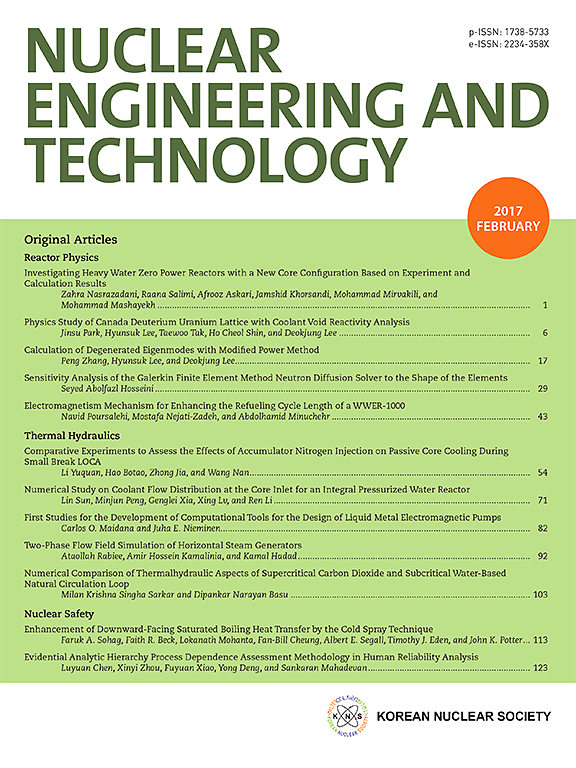Experimental research on fluid elastic instability in rod bundles subjected to lead-bismuth eutectic (LBE) cross-flow
IF 2.6
3区 工程技术
Q1 NUCLEAR SCIENCE & TECHNOLOGY
引用次数: 0
Abstract
Flow-induced vibration (FIV) is a common cause of equipment breakdown and is prevalent in engineering applications. Lead-bismuth eutectic (LBE) fluid has emerged as a new heat exchange medium in recent years. Understanding the FIV characteristics of rod bundles in liquid LBE is crucial for engineering issues such as the design of rod bundle arrangements and the safety validation of heat exchangers. Based on a designed FIV experimental system in LBE, this paper primarily investigates the fluid elastic instability (FEI) characteristics of rod bundles in cross-flow LBE. The vibration time-history curve and spectral responses at various reduced velocities were analyzed. The effect of surrounding rod stiffness, arrangement pattern, and pitch ratio on the critical reduced velocity (Vpcr) under different rod bundle configurations was investigated. The results show that in LBE, within the pitch ratio range of 1.6–2.5, for cantilever beam-type rod bundles, the effect of vortex shedding on the rod bundle cannot be ignored in LBE. Strouhal number (St) for the normal triangle rod bundles composed of fully flexible rods and non-fully flexible rods with a pitch ratio of 1.6 in LBE is 0.203 and 0.315, respectively. Streamwise FEI is strongly correlated with inter-rod coupling, and arranging flexible rods around the rod can induce streamwise FEI. Although inter-rod coupling is not the main factor affecting transverse FEI, as the number of flexible rods increases, the Vpcr for transverse FEI decreases. Arranging flexible rods around the rod reduces the stability of the rod bundle. Within the pitch ratio range of 1.6–2.5, as the pitch ratio increases, the Vpcr decreases, and the permissible inlet velocity increases. When the pitch ratio is 1.6, the Vpcr for streamwise FEI is nearly the same as that for transverse FEI, with streamwise FEI more likely to occur in the central rod. When the pitch ratio is 2.5, transverses FEI occurs earlier than streamwise FEI, and the Vpcr for the central rod and downstream rod are almost the same. When the pitch ratio is 1.6, the downstream rod is located at the end of the rod bundle, which is not synchronized with the vibration of the central rod. When the pitch-to-diameter ratio is 2.5, the central rod and downstream rod vibrate in nearly perfect synchronization.
求助全文
约1分钟内获得全文
求助全文
来源期刊

Nuclear Engineering and Technology
工程技术-核科学技术
CiteScore
4.80
自引率
7.40%
发文量
431
审稿时长
3.5 months
期刊介绍:
Nuclear Engineering and Technology (NET), an international journal of the Korean Nuclear Society (KNS), publishes peer-reviewed papers on original research, ideas and developments in all areas of the field of nuclear science and technology. NET bimonthly publishes original articles, reviews, and technical notes. The journal is listed in the Science Citation Index Expanded (SCIE) of Thomson Reuters.
NET covers all fields for peaceful utilization of nuclear energy and radiation as follows:
1) Reactor Physics
2) Thermal Hydraulics
3) Nuclear Safety
4) Nuclear I&C
5) Nuclear Physics, Fusion, and Laser Technology
6) Nuclear Fuel Cycle and Radioactive Waste Management
7) Nuclear Fuel and Reactor Materials
8) Radiation Application
9) Radiation Protection
10) Nuclear Structural Analysis and Plant Management & Maintenance
11) Nuclear Policy, Economics, and Human Resource Development
 求助内容:
求助内容: 应助结果提醒方式:
应助结果提醒方式:


